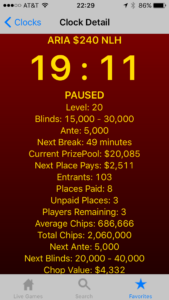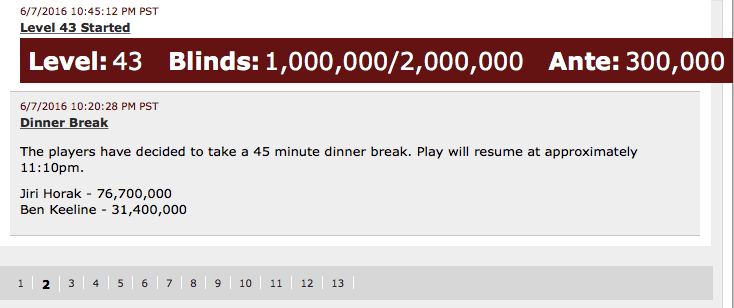At the Portland Meadows tournament on Saturday, one of the dealers (and I apologize for not remembering which) asked me how to figure out how long a tournament lasted.
Before the tournament happens, that’s not always easy. Tournament directors have rules of thumb—they have to in order to estimate scheduling needs for staff and room space—but even the WSOP has had to rearrange portions of its schedule every year: events get more players than expected, changes to structures have unforseen consequences, etc. Structure changes and increased chip stacks a couple of years back led to a number of WSOP events reaching the bubble considerably later than in previous years, particularly in the limit events. You can read bout that in an article I did for PokerNews.
As it turns out, though. the question was about events in the past, specifically the Colossus. And helpfully, it was about WSOP events. That meant we were talking about some of the best-documented events in the poker world.
If you’re not already aware of it, the WSOP web site has live reporting archives from nearly every bracelet event for the past decade or so. Many of the CIrcuit Main Events are also represented. I worked for the live reporting team at the WSOP last year, and one of your duties as a live reporter is to insert Level updates each time the blinds go up. Finding out what the last blind level was in a WSOP tournament is as easy as:
- Find the year and event you want from the popup menu at the top of the page and select “GO.”
- Click the “UPDATES” tab. That always takes you to the last report for the event whenever you switch events.
- Scroll down to the bottom of the page and look for a level notice like the one below.
- If you don’t see a level notice, select the next page (they’re in reverse chronological order starting on page 1) and repeat item 3 until you find the last level started.
In the case of the Colossus II (2016), the players were heads-up going into Level 43. In the last stages of a tournament, there will be frequent chip updates, as there was before the last level in the example below, and you can see that the two players had about 54bb between them (Keeline was the eventual winner). Cord Garcia won the larger Colossus I in 2015 in Level 41, with blinds at 500K/1M/150K, with a little more than 100bb in play.
The heads-up battle between Qui Nguyen and Gordon Vayo ended with more than 100bb in play. Other events at the WSOP have ended with as many as 150bb between the last players. On the other hand, when I was involved in a chop last week at Final Table, there were six players with fewer than 90bb in play.
The WSOP archives really are a mine of useful information. Ive mined them for other articles over the years. Is there a best day to play the Main Event (or any other event)? Check it out.


